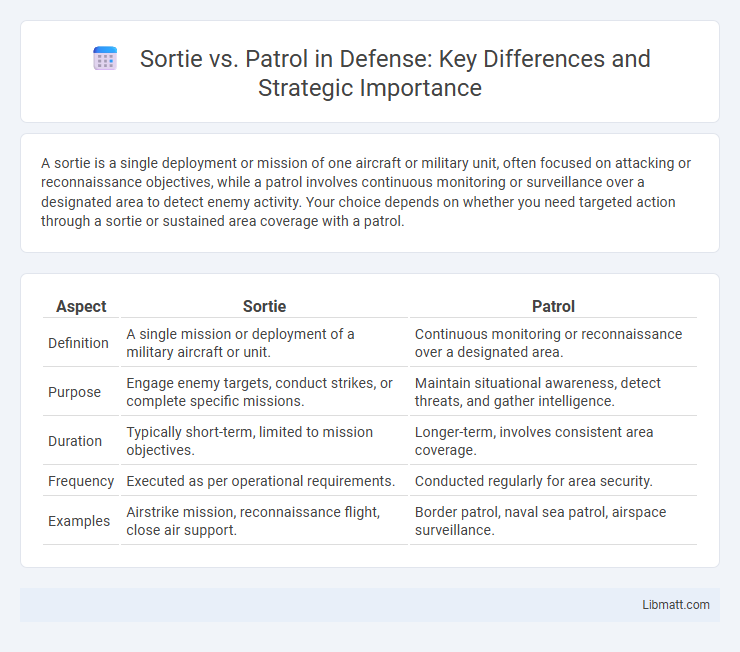A sortie is a single deployment or mission of one aircraft or military unit, often focused on attacking or reconnaissance objectives, while a patrol involves continuous monitoring or surveillance over a designated area to detect enemy activity. Your choice depends on whether you need targeted action through a sortie or sustained area coverage with a patrol.
Table of Comparison
| Aspect | Sortie | Patrol |
|---|---|---|
| Definition | A single mission or deployment of a military aircraft or unit. | Continuous monitoring or reconnaissance over a designated area. |
| Purpose | Engage enemy targets, conduct strikes, or complete specific missions. | Maintain situational awareness, detect threats, and gather intelligence. |
| Duration | Typically short-term, limited to mission objectives. | Longer-term, involves consistent area coverage. |
| Frequency | Executed as per operational requirements. | Conducted regularly for area security. |
| Examples | Airstrike mission, reconnaissance flight, close air support. | Border patrol, naval sea patrol, airspace surveillance. |
Understanding the Concepts: Sortie vs Patrol
A sortie refers to a single mission or deployment of an aircraft, ship, or military unit for a specific objective, often emphasizing quick, targeted action. A patrol involves continuous or repeated movement through a designated area to monitor, secure, or gather intelligence, focusing on sustained presence and area control. Understanding the distinction clarifies operational goals: sorties prioritize mission execution, while patrols prioritize area surveillance and security.
Definitions: What is a Sortie?
A sortie is a single operational flight or mission by a military aircraft, often launched from an airbase to accomplish a specific objective such as reconnaissance, combat, or transport. It represents one complete journey from takeoff to landing, emphasizing the execution of targeted tasks within a set timeframe. Understanding sortie parameters helps optimize mission planning and resource allocation for Your air operations.
Defining Patrol Operations
Patrol operations involve systematic movement within a designated area to monitor, observe, and maintain security, differing from sorties that are specific offensive or reconnaissance missions. A patrol is primarily preventative, focusing on detecting threats, gathering intelligence, and establishing a visible presence to deter enemy activity. Your understanding of patrol operations enhances strategic planning by emphasizing persistent area control rather than isolated tactical engagements.
Key Differences Between Sortie and Patrol
A sortie refers to a single mission or deployment of a military aircraft or unit, emphasizing its specific operational objective and duration. In contrast, a patrol involves continuous monitoring or reconnaissance over an assigned area to maintain security or gather intelligence. Your understanding of these terms is crucial for accurately assessing military strategies and operational planning.
Objectives: Sortie Missions vs Patrol Missions
Sortie missions focus on specific objectives such as attacking targets, reconnaissance, or delivering supplies, requiring precise execution within a defined timeframe. Patrol missions emphasize continuous surveillance, securing an area, and detecting threats over an extended period to maintain situational awareness. Your operational strategy benefits by understanding the distinct purposes of sorties for targeted actions and patrols for persistent area control.
Operational Scenarios for Sorties
Sorties are typically deployed in high-intensity operational scenarios involving specific, time-sensitive missions such as combat engagements, strategic airstrikes, or targeted reconnaissance where rapid response and precise objectives are critical. Unlike regular patrols that monitor and maintain persistent area security, sorties execute focused tasks often requiring quick repositioning, concentrated firepower, and immediate withdrawal after mission completion. Understanding these distinctions ensures Your operational planning aligns with mission priorities, resource allocation, and risk management in dynamic combat environments.
Typical Patrol Environments
Typical patrol environments include urban areas, wilderness, border zones, and naval waters where constant vigilance and area security are essential. Patrols operate in diverse conditions, ranging from foot patrols in forests to vehicle or boat patrols along coastal regions, adapting to the terrain and mission requirements. Your ability to understand the environment ensures effective monitoring and rapid response to any unusual activity during a patrol.
Advantages and Limitations of Sorties
Sorties offer rapid deployment capabilities that enable immediate response to dynamic combat situations, making them highly effective for tactical strikes and precise missions. Limitations include high operational costs, limited endurance due to fuel and ammunition constraints, and vulnerability to enemy defenses without adequate support. Your mission planning should weigh these factors to optimize sortie effectiveness while mitigating risks through coordinated patrols and strategic resource allocation.
Benefits and Challenges of Patrols
Patrols provide continuous surveillance and quick response capabilities, enhancing security and situational awareness in a designated area. The challenges of patrols include resource-intensive deployment, potential fatigue for personnel, and limited coverage scope compared to sorties. Your operational success depends on balancing the sustained presence of patrols with the targeted, intensive impact offered by sorties.
Choosing Between Sortie and Patrol in Military Strategy
Choosing between sortie and patrol in military strategy depends on mission objectives and operational context. Sorties focus on offensive or targeted strikes, executing specific, high-impact operations, whereas patrols emphasize area control, intelligence gathering, and maintaining presence to deter enemy activity. Commanders optimize force deployment by balancing sortie frequency with continuous patrols to achieve strategic dominance and situational awareness.
sortie vs patrol Infographic

 libmatt.com
libmatt.com